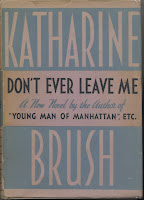Reading the reviews today, I am reminded of that assessment by the Times in 1944: “the interesting thing about Katharine Brush's work has always been not so much what she says as how she says it.”
Regarding the how of Leave Me, one finds little in a negative vein:
“The large audiences that were captured by Young Man of Manhattan and Red-Headed Woman will not be disappointed…” (Leane Zugsmith, NYT)
“[Brush] has achieved a slick-as-cream smoothness which lesser popular writers must envy desperately…On certain contemporary matters her work is definitive.” (Edith H. Walton, The Youngstown Daily Vindicator)
The what, on the other hand, left the same critics unsatisfied.
Here’s Chamberlain:
Superficially, Miss Brush is a novelist of Scott Fitzgerald’s order. But only superficially. Both of them have very retentive memories for the ephemeral that gives each year its special tone. But…Fitzgerald is interested in character, in people making moral decisions. Miss Brush tries to be. But the typical and the topical are always diverting her…[T]he world of character, of moral decision, is neglected…
And although Walton thought the novel warmer than Red-Headed Woman, and found in it “faint, undeveloped traces of social consciousness,” she predicted that the book would be “unbearably nostalgic” ten years into the future. She twists the knife a bit by concluding that Don’t Ever Leave Me “will disappoint only those naïve optimists who once supposed, on the basis of her short stories, that Katharine Brush might develop into a writer of consequence.”




No comments:
Post a Comment